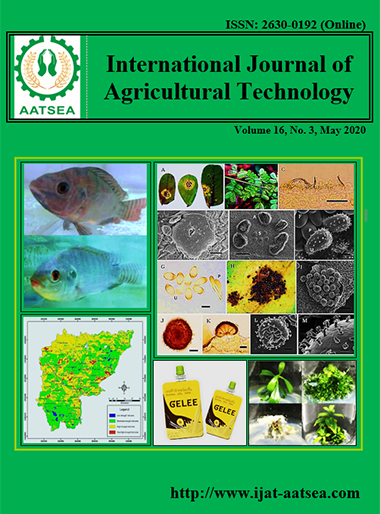Drought risk area assessment using GIS in Sa Kaeo Province, Thailand
Main Article Content
Abstract
Geographic Information System (GIS) model was used to assess drought risk area in Sa Kaeo Province, Thailand. Results indicated that total area of low, moderate, high, and very high drought risk were 103,394 m2 (1.44%), 3,482,673.76 m2 (48.40%), 3,406,193.74 m2 (47.34%) and 203,174.31 m2 (2.82%), respectively. The historical drought information and field surveys were compared to evaluate the accuracy of model prediction, which was 77.35%. Relationships between studied environmental factors and the drought risk were examined, and the results showed both positive and negative correlations. The factors expressing significant positive correlations with drought risk from high to low were distanced from irrigation area, volume of groundwater, slope, soil drainage, distance from water sources and land use with Pearson correlation coefficients of 0.743, 0.534, 0.510, 0.476 and 0.265, respectively. Meanwhile, the averaged annual rainfall was a negative correlation with drought risk, with Pearson coefficient of -0.853. The results can be used as information for the local administration to help alleviate the effects of continued drought in Sa Kaeo Province.
Article Details

This work is licensed under a Creative Commons Attribution-NonCommercial-NoDerivatives 4.0 International License.
References
Alam, J. B., Nahar, T. and Shaha, B. (2008). Evaluation of National Highway by Geographical
Information System. International Journal of Environmental Research, 2:365-370.
Chanchaeng, P. (2010). Drought Risk Area Assessment in Kampaengsaen District, Nakhonpathom Province Using Geogrงaphic Information System (Master’s thesis). National Institute of Development Administration, Thailand.
Dhanarun, S. and Amornsanguansin, J. (2010). Application of Geographic Information System
for Flood Risk Area Assessment in Angthong Province. Journal of Environmental Management, 6:19-34.
Dolores, G. B. and Jose, A. G. (2019). Insuring Water Supply in Irrigated Agriculture: A Proposal for Hydrological Drought Index-Based Insurance in Spain. Water. 11. Retrieved from http://www.mdpi.com/journal/water.
Faryadi, S. and Taheri, S. (2009). Interconnections of Urban Green Spaces and Environmental Quality of Tehran. International Journal of Environmental Research, 3:199 - 208.
Hydro and Agro Informatics Institute (2017). Drought nov52-april53. Retrieved from www.thaiwater.net/web/index.php/drought/110-drought-2553/237-drought-nov52-april 53.
Khongsanun, S. (2009). Drought Risk Area Assessment Based on Indices Variation in Tak Province, Thailand using Geo-Informatics (Master’s thesis). Mahidol University, Thailand.
Lin, M. L and Chen, C. W. (2010). Application of fuzzy model for the monitoring of ecologically Sensitive ecosystem in a dynamic semi-arid landscape from satellite imagery. Engineering Computations: International Journal for Computer-Aided Engineering and Software, 27:5-19.
Mahiny, A. S. and Gholamalifard, M. (2007). Dynamic Spatial Modeling of Urban Growth through Cellular Automata in a GIS Environment. International Journal of Environmental Research, 1:272-279.
Na-U-Dom, T., Intacharoen, P., Thodsan, T. and Jangkorn, S. (2020). Drought Assessment during Dry Season Derived from LANDSAT Imagery using Amplitude Analysis in Sa Kaeo, THAILAND. In Monprapussorn, S., Lin, Z., Sitthi, A. and Wetchayont, P. (eds.). Springer Geography:Geoinformatics for Sustainable Development in Asian Cities. Switzerland: Springer International Publishing, pp. 68-74.
Noichaisin, L., Buranapratheprat, A., Manthachitra, V. and Intarawichian, N. (2019). The influence of El Nino on water shortage area in Sa Kaeo province, Thailand by using GIS. International Journal of Agricultural Technology, 15:723-734.
Office of Prevention and Mitigation Sa Kaeo (2016). Annual Reprt 2016. Retrieved fromhttp://122.155.1.141/upload/minisite/file_attach/45/58e74afe2335b.pdf.
Pijanowski, B. C., Tayyebi, A., Delavar, M. R. and Yazdanpanah, M. J. (2009). Urban Expansion Simulation Using Geospatial Information System and Artificial Neural Networks. International Journal of Environmental Research, 3:493-502.
Punprasit, J. (2006). Geographic information system for drought risk area assessment by regression analysis in Lop Buri province (Master’s thesis). Mahidol University, Thailand.
Solaimani, K., Mohammadi, H., Ahmadi, M. Z. and Habibnejad, M. (2005). Flood occurrence hazard forecasting based on geographical information system. International Journal of Environmental Science and Technology, 2:253-258.
Soytong, P., Janchidfa, K., Phengphit, N. and Chayhard, S. (2018). Monitoring urban heat island in the Eastern region of Thailand and its mitigating through greening city and urban agriculture. International Journal of Agricultural Technology, 14:2271-2294.
Srisurat, S. (2000). Water resources in Thailand. Geographical Journal, 8:1-14.
Thailand Institute of Scientific and Technology (1999). Assessing the risk area of flooding and drought in central basin by using geographic information system. Bangkok Office of Natural Resources and Environmental Policy and Planning.
Thai Meteorological Department (2017). Climate Change. Retrieved from:www.tmd.go.th/ info.php?FileID=86.
Thai Meteorological Department (2019). Average rainfall in Thailand. Retrieved from:www.tmd.go.th/.
Water Crisis Prevention Center (2018). Annual Report 2016-2017. Retrieved from http://mekhala.dwr.go.th/imgbackend/doc_file/document_104526.pdf.


